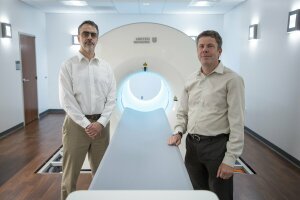by
John R. Fischer, Senior Reporter | July 19, 2021

UC Davis researchers have proposed extended measurements for phantoms to more appropriately evaluate total-body imaging
Researchers at the University of California, Davis claim that the uEXPLORER total-body PET/CT scanner’s spatial resolution and image quality go beyond industry standards.
Their conclusion is based on a performance evaluation of the scanner’s ultrahigh sensitivity and has led the scientists to propose new, extended measurements for phantoms to more appropriately characterize total-body PET imaging.
“We did measurements on phantoms that were much longer (~165 cm), in order to better model the human body and the long scanning field of view of the uEXPLORER scanner. These are more than twice the length of the phantoms (70 cm) used on conventional scanners,” Simon Cherry, co-leader of the EXPLORER Consortium and a professor of biomedical engineering at the University of California, Davis, told HCB News.



Ad Statistics
Times Displayed: 364961
Times Visited: 6953 Quality remanufactured Certified Centrifuges at Great prices! Fully warranted and backed by a company you can trust! Call or click for a free quote today! www.Centrifugestore.com 800-457-7576
Testing was based around the National Electrical Manufacturers Association (NEMA) NU 2-2018 standard, which defines a set of experiments and analyses using standardized imaging phantoms to compare different PET systems.
The researchers used phantoms and conducted human studies for further characterization of uEXPLORER’s sensitivity, count-rate performance, time-of-flight resolution, spatial resolution, image quality and accuracy of corrections based on NEMA NU 2-2018 standards. The scanner showed approximately 15 to 68 times higher sensitivity than conventional PET systems. Spatial resolution was rated as excellent and was well supported by an increased image signal to noise ratio, as a result of the higher sensitivity.
The authors note, however, that measurements for this standard are defined only for PET scanners with an axial field of view (AFOV) of 65 cm or less, making it unsuitable for long-AFOV scanners, like the 194 cm-long uEXPLORER. As a result, they devised additional informative phantom measurements.
Cherry says the phantoms enable scientists to test all aspects of the system in great detail, which helps optimize all uEXPLORER scanner software and imaging protocols to determine appropriate uses in clinical settings. He adds that they can provide greater understanding for human scanning, which is more complex due to different size and weight ranges and the limited information researchers have about individual biological profiles.
“There is biological variation between humans that impacts radiotracer distribution. The phantom experiments are just a rough guide to what will happen in humans, but nonetheless a very important guide, especially if the phantoms are appropriately designed to match conditions in human imaging.”
The findings were published in the June edition of
The Journal of Nuclear Medicine.

